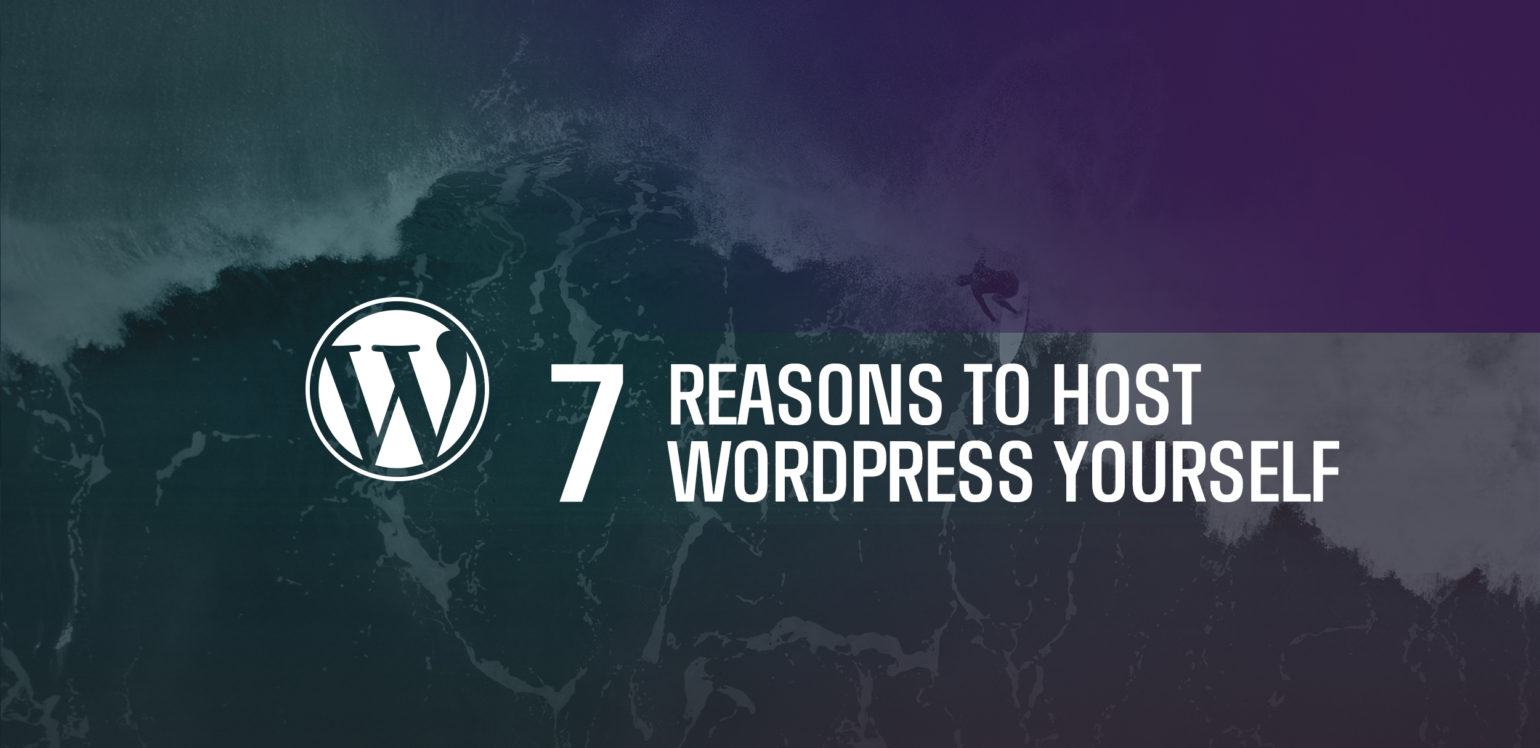Back in 2017, we published part 1 of what would become our most popular articles to date, our Install WordPress on Ubuntu 22.04 series (formerly Hosting WordPress Yourself). The article jumps right into setting up your server, but doesn’t ask the question: Why host WordPress yourself?
To begin to answer this question, we have to first understand the options for hosting WordPress.
WordPress Hosting Options
There are three main categories for hosting a WordPress site these days:
- Shared web hosting
- Managed WordPress hosting
- Do-It-Yourself hosting
Shared Web Hosting
Shared web hosting is as old as the web hosting industry itself. For a ridiculously low monthly fee, you get space on a server with dozens if not hundreds of other customers, all sharing CPU and memory resources. If you’re wondering if this is GoDaddy’s $3/month plan, you’ve got it.
Your plan usually comes with cPanel or Plesk control panel access where you can 1-click install WordPress and dozens of other web apps. If you run into trouble, technical support is available via email but at $3/month don’t expect to get the sharpest replies to your support requests.
Managed WordPress Hosting
With managed WordPress hosting, the hosting platform is tailored to WordPress. Hosting another web app might be possible, but it’s not what it was designed for and problems are likely.
This category of WordPress hosting was pioneered by Pagely in 2006 but really hit mainstream when WP Engine burst onto the scene in 2010. These days it’s tough to find a web host who doesn’t offer a managed WordPress hosting option.
Control panels for these platforms are custom-built and offer WordPress-specific tools and controls. Technical support via email is included as well should you need assistance and responses are usually pretty sharp.
Do-It-Yourself (DIY)
DIY hosting has been around since the beginning of the internet. Back in the day you might set up a machine in your closet (bonus: toasty shirts on-demand), but nowadays a 1 CPU / 1 GB RAM virtual private server (VPS) costs just $5/month and has all the benefits of a modern data center.
As is evident from our Install WordPress on Ubuntu 22.04 series (formerly Hosting WordPress Yourself), the DIY approach requires some knowledge and experience managing servers or a willingness to learn, and troubleshooting skills. If something goes wrong, you have Google, your own brain, and maybe some friends you can bother.
There’s no safety net unless you’ve paid extra for one. For example, Akamai/Linode currently offers 24×7 managed incident response for $100/month/server.
DIY with Help
Out of the above three options, it might seem like a no-brainer that you should go with managed WordPress hosting, but there is a kind of hosting service that lies in-between managed and DIY. This service has been available in the non-WordPress world for years, but is relatively new to the WordPress scene.
The idea is a simple one: spinning up a server, configuring it, and maintaining it is a pain, so let’s solve some of those problems and make the unsolvable ones far less painful. You get all the benefits of DIY minus most of the negatives. This is the idea behind Laravel Forge, ServerPilot, and our app SpinupWP.
7 Reasons to Host WordPress Yourself
1. Level Up
If you aren’t already comfortable managing your own server, by far the best reason to host WordPress yourself is to learn something new.
Start with a low-risk site like a personal blog, go through our Install WordPress on Ubuntu 22.04 series (formerly Hosting WordPress Yourself), and see what happens. If you manage to get through it, you’ll have a much better understanding of how to set up a server for hosting WordPress. And after 6-12 months of hosting your own site you’ll have confidence to try hosting another site.
With time, you’ll be ready to take the next step and host a site of slightly higher risk like a client’s brochure site. With every site you host and every day that goes by with you in control, you gain confidence. Before long you’ll be using an app like SpinupWP to help you quickly spin up more servers and help you maintain them.
2. Page Speed
Time is money and nowhere is that more true than ecommerce. If you’re running a WooCommerce store, your pages should be loading in under 300 milliseconds, otherwise you’re leaving money on the table.
By hosting WordPress yourself, you have control to tweak caching rules and optimize your sites at the server level. And you can have dedicated CPU and memory that won’t be shared with anyone else.
With shared web hosting and some managed WordPress hosts, you can experience slow-downs due to other customers on the platform using more than their fair share of CPU and memory resources.
3. Cost
Managed WordPress hosting is expensive. You can expect to spend $400 per year for just a single site and over $1,200/year for 2-5 sites. And that’s just assuming you have moderate traffic. If you have high traffic, the costs balloon. The more sites and the more traffic you have, the more expensive it gets.
With your own server you can have as many sites as you like with as much traffic as it can handle (which is probably a lot more than you might think). If you have a few dozen brochure sites that are rarely updated and have full-page caching enabled, you could easily have them all on a $10/month VPS and handle a lot of traffic without issue.
If you’d like the convenience and help that comes with an app like SpinupWP, your costs only go up an extra $12/month.
Shared web hosting is cheap, but in both senses of the word. Sure it’s inexpensive, but you get what you pay for: competing with other customers for server resources and support that’s not very technical or helpful.
4. Full Control
One of the biggest advantages of having your own server is that you are in full control. You have root access to do whatever you like on the server.
Need to install a PHP extension? Do it.
Think tweaking the caching rules will speed your site up? For sure try that.
Want to install a fancy little Go app you found on GitHub? Go ahead.
But of course, with great power comes great responsibility.
The more customizations, the more you will need to maintain and keep track of for the next time you rebuild the server.
Many would say that full control is as much a disadvantage as it is an advantage. That an advantage of shared and managed WordPress hosting is that you aren’t tempted to make customizations so you’re forced to keep things simple. But what’s simple about a low conversion rate and leaving money on the table?
The reality is that your hosting environment is restricted with managed WordPress hosts. Many don’t even offer SSH access or have support for Git.
5. Simplicity Promotes Stability
A single VPS configured to host a single WordPress site with standard Ubuntu packages is the simplest, most stable way I know to host WordPress sites. It’s a tried-and-tested setup that is easy to understand and maintain.
The biggest flaw in this setup is a lack of redundancy. All your eggs are in one basket. If your server goes down, your site is down until you can get it back up.
This usually leads people to explore server clusters, where requests for your site are served by several servers and if one server goes down, the rest continue to serve requests. I first learned about clustering in 2004 and it was exciting. It sounded like the perfect system. But in practice, it’s a lot more moving parts, harder to maintain, and creates more problems. Not to mention a lot more costly.
Many managed WordPress hosts tout the advanced technology they’ve built into their clustered platforms and their redundancy. But I’m certain it’s not as reliable as they say, and likely not as reliable as a boring ‘ol, single VPS.
In my experience hosting VPSs over the past seven years, a VPS going down is a rare event and not worth protecting against. DigitalOcean, Akamai/Linode, and other VPS providers are incredibly good at avoiding downtime due to physical hardware failure. In fact, I haven’t experienced it myself.
The much more common cause of downtime that I’ve endured many times is network-level issues. In fact, this site experienced some downtime just a couple of weeks ago due to connectivity issues at Akamai/Linode’s Newark data center, where our VPS resides. Although their diagnosis of the problem was inconclusive, it is very interesting and shows just how complex the underlying network infrastructure is before you even get to the server-level.
A cluster is typically set up within one data center, so it’s not going to save you from a networking issue. And a multi data center cluster would be even more complex and fragile and probably cause more downtime than the network issues it’s protecting against.
In the end, you just have to accept that even Twitter, Google, and Facebook experience some downtime and you will too.
6. Hands Off My Server
The web hosting industry and most web hosts are constantly innovating and trying to enhance their platform to gain an edge on their competition. They’re constantly working on better load balancers, bigger log aggregators, optimized server settings, etc.
But in this race to outdo one another, problems are born. Even the most responsible web hosts make mistakes. And even without mistakes, some problems show up in production that didn’t show in staging. It probably won’t happen often, but when it does it’s unlikely you will be expecting downtime and the timing probably won’t be convenient for you.
With your own server, no one will be working on it except you or your team. You can work on your server when you know you’ll be online for awhile, can keep an eye on things, and deal with any problems that arise.
To be clear, we’re not talking about security updates here. Whether it’s managed WordPress hosting or your own server, everyone should be installing security updates as they are released.
7. Productize Your Service
If you’re a freelancer or an agency, you know all too well the feast or famine cash flow of your business. What would you give for a nice, predictable recurring monthly income?
Selling a maintenance plan to your clients is a great start, but it’s not sticky. It will be the first thing to go when a client is looking at cutting their costs. But what if you created a bundle that included hosting and maintenance? It’s certainly a lot harder to move hosting providers than it is to cancel a maintenance plan.
Hosting client sites is hardly a new concept, but the profitability of hosting can lead many freelancers and agencies to abandon the idea. How much will your client be willing to pay over the cost of a managed WordPress host? And who will they contact when their site is down?
As we’ve already discussed in #3, the cost of hosting your own server is extremely low and so the profitability per client is much higher. You may be worried about collecting payments, but there are simple solutions to this problem. Combine a payment gateway like Stripe and a Stripe-enabled WordPress plugin like WP Simple Pay and you’ll be able to accept multiple payment methods in the same time that it takes to embed a form on your site.
So revisit #1 and start learning how to host WordPress sites yourself, start your journey to hosting your client sites, and bringing in nice, predictable monthly recurring revenue.
Conclusion
Although hosting WordPress yourself can seem scary to those who haven’t done it, it’s really just fear of the unknown. By taking an educational approach and starting with low-risk sites, you can ease into it with little-to-nothing to lose and plenty to gain.
Eventually you end up with faster sites that you’re in full control of. You’ll have confidence in your hosting, knowing every part of it, and find that your sites are more stable than ever. No one will be tinkering with your server infrastructure while you’re not around.
Finally, with your new confidence and the high-profit margins of hosting WordPress yourself, you can start hosting client sites, receive monthly recurring revenue, and transform your business to predictable cash flow.
How does that sound to you? What’s preventing you from getting started on this journey?




